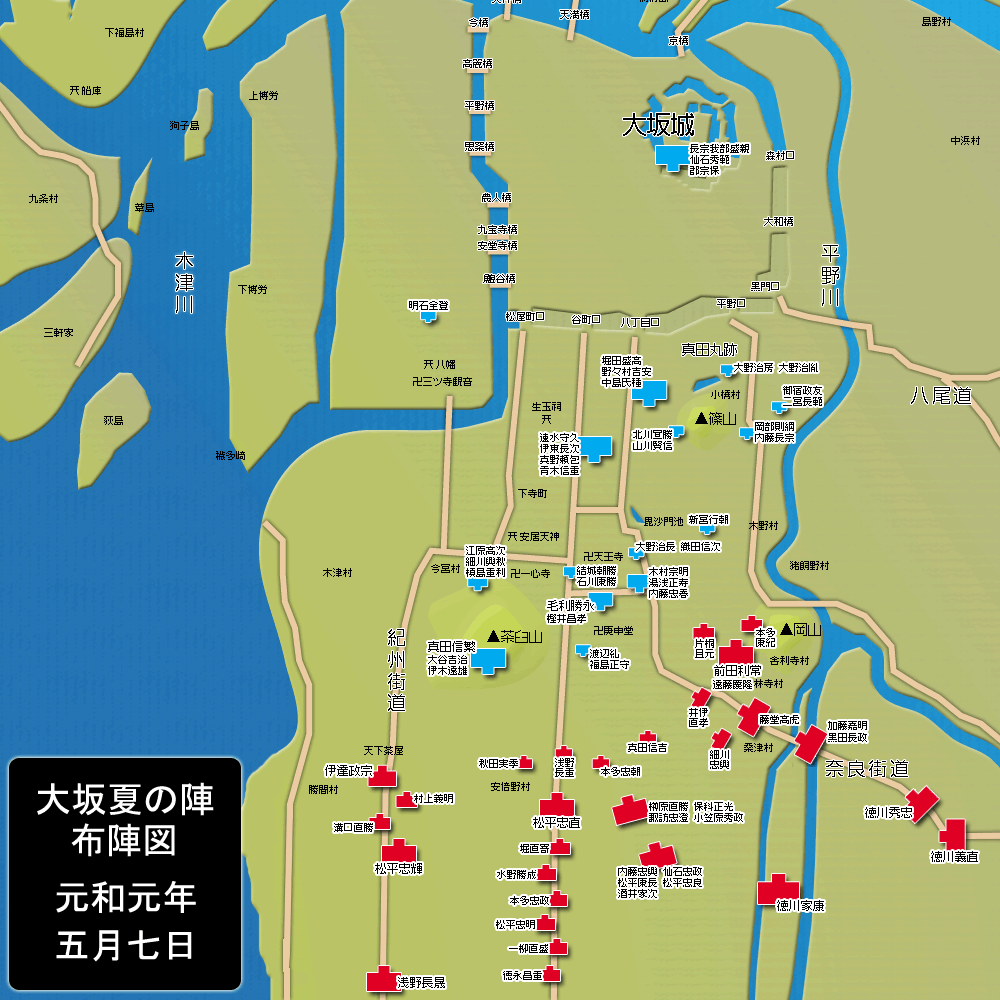Battle Of Tennōji on:
[Wikipedia]
[Google]
[Amazon]
 The was fought on 3 June, 1615 between the forces of
The was fought on 3 June, 1615 between the forces of
 The was fought on 3 June, 1615 between the forces of
The was fought on 3 June, 1615 between the forces of Tokugawa Ieyasu
Tokugawa Ieyasu (born Matsudaira Takechiyo; 31 January 1543 – 1 June 1616) was the founder and first ''shōgun'' of the Tokugawa shogunate of Japan, which ruled from 1603 until the Meiji Restoration in 1868. He was the third of the three "Gr ...
and Toyotomi Hideyori
was the son and designated successor of Toyotomi Hideyoshi, the general who united all of Japan toward the end of the Sengoku period. His mother, Yodo-dono, was the niece of Oda Nobunaga.
Early life
Born in 1593, he was Hideyoshi's sec ...
. Tokugawa was besieging Osaka, and Hideyori had planned a counterattack. Both sides were plagued by mistakes until Hideyori's side finally fell. He presumably committed suicide. The Toyotomi army suffered nearly 50% casualties in this battle, with more than 15,000 dead. This was also the final battle of Sanada Yukimura.
Battle
The last resistance of the Osaka Garrison was at Tennoji, outside of the castle. Hideyori, son of the legendaryToyotomi Hideyoshi
, otherwise known as and , was a Japanese samurai and ''daimyō'' (feudal lord) of the late Sengoku period, Sengoku and Azuchi-Momoyama periods and regarded as the second "Great Unifier" of Japan.Richard Holmes, The World Atlas of Warfare: ...
, made up a plan to try and turn the tide of the siege. A council of war
A council of warŌno Harunaga, and the other commanders would launch an attack to hold the Tokugawa front, while Akashi Morishige would sweep around to attack the rear. In the midst of the rear attack, Hideyori would ride out of the garrison, leading the attack under the banner of Hideyoshi.
But the Tokugawa were led by Ieyasu himself, and even though Ieyasu was wounded by a spear thrust, Sanada was killed in action, beheaded by a samurai named Nishio Nizaemon after he sat on a stool to rest. Thus, Morishige's attack failed as well. This left only Hideyori to defend the castle. Ieyasu left Ii Naotaka to keep watch over the Toyotomi family and secure the castle. Naotaka began to blast the castle with every piece of artillery available and it soon caught fire. Hideyori and his mother
Yodo-dono
or (1569 – June 4, 1615), also known as Lady Chacha (茶々), was a Japanese historical figure in the late Sengoku period. She was the concubine and the second wife of Japanese ruler Toyotomi Hideyoshi. As the mother of his son and successor ...
committed ''seppuku
, also known as , is a form of Japanese ritualistic suicide by disembowelment. It was originally reserved for samurai in their code of honor, but was also practiced by other Japanese people during the Shōwa era (particularly officers near ...
''. The eight-year old son of Hideyori, the last of the Toyotomi, was decapitated, along with Chōsokabe Morichika, along with so many rōnin
In feudal Japan to early modern Japan (1185–1868), a ''rōnin'' ( ; , , 'drifter' or 'wandering man', ) was a samurai who had no lord or master and in some cases, had also severed all links with his family or clan. A samurai became a ''rō ...
that it was said their heads stretched from Kyoto
Kyoto ( or ; Japanese language, Japanese: , ''Kyōto'' ), officially , is the capital city of Kyoto Prefecture in the Kansai region of Japan's largest and most populous island of Honshu. , the city had a population of 1.46 million, making it t ...
to Fushimi.
Meanwhile, the Ii clan
is a Japanese clan which originates in Tōtōmi Province. It was a retainer clan of the Imagawa clan, Imagawa family, and then switched sides to the Matsudaira clan of Mikawa Province at the reign of Ii Naotora. A famed 16th-century clan membe ...
has send their unit of ninja
A , or was a spy and infiltrator in pre-modern Japan. The functions of a ninja included siege and infiltration, ambush, reconnaissance, espionage, deception, and later bodyguarding.Kawakami, pp. 21–22 Antecedents may have existed as ear ...
under the lead of Miura Yo'emon, Shimotani Sanzo, Okuda Kasa'emon, and Saga Kita'emon to fought together with Tokugawa's regular soldiers in the south gate of the castle.
Aside from minor skirmishes, the Battle of Tennōji was the last battle between two great samurai armies ever fought.
References
Battles involving Japan 1615 in Japan Conflicts in 1615 Military history of Osaka 17th-century military history of Japan 17th-century battles Building bombings in Japan Residential building arson attacks in Japan Residential building bombings in Asia Attacks on castles in Japan {{Japan-battle-stub